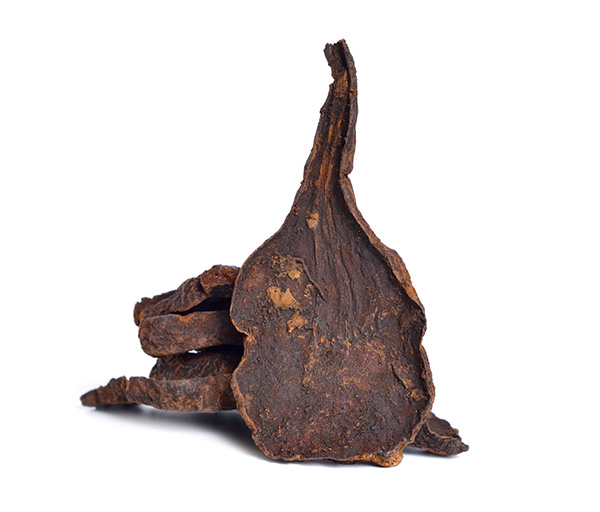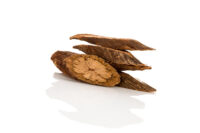
Dried Black Bean Wild HeShou Wu,Natural Polygonum Multiflorum Root, Fo-ti
The root of he shou wu (Polygonum multiflorum), also known as “fleece flower,” has been popularly in use for centuries as a rejuvenative longevity tonic as well as for lowering cholesterol, swollen glands, abscesses, non-healing sores, ulcerations, malaria, and constipation.
In recent months, however, there have been a number of reports, mostly coming out of China, alleging that some who used he shou wu were experiencing symptoms of hepatitis. Furthermore, it was found in these cases that when they stopped taking the herb, the hepatitis went into total remission.
While this has not resulted in a total ban on the use of he shou wu, it has been a cause of concern among practitioners who prescribe it clinically and patients who use it in the many popular forms available both as a single herb and in the popular rejuvenative tonic wine called Shou Wu Chih which is considered to tonify two of the most important organ systems of the body, the Kidney-adrenals and the Liver. One of the reasons that he shou wu is popular as a regenerative tonic is because of all the tonics in TCM, it is the only one that tonifies without causing symptoms of stagnation.
What’s going on with he shou wu and reports of hepatitis?
The best TCM herbalists, including Andy Ellis of Spring Wind, Roy Upton of the American Herbal Pharmacopeia, and Ron Teeguarden of Dragon Herbs, have concluded that despite the claims of hepatitis associated with a limited number of cases coming out of China, these were probably caused by inadequate processing, and there is no reason to refrain from taking properly prepared he shou wu even on a daily basis as a tonic.
Recently there have been more than a few reported cases of liver toxicity causing symptoms of hepatitis because of a high presence of anthraquinones found in many herbs that are used as laxatives. This property was well known by ancient Chinese herbalists who devised an unusual method to lessen the laxative properties of he shou wu, which was to stew or steam the herb in black soybean juice for several hours to three days, then dry the roots. This process not only reduces the laxative properties of uncooked he shou wu but changes it to a tonic especially for aging men and women for daily use.
Many commonly used herbs such as senna and rhubarb root contain anthraquinones. One of the most popular, which up until recently could be found as a liquid tonic laxative, is Cascara sagrada. This is a short tree found growing in the Pacific Northwest where harvesting its bark was once a profitable industry in the region. Many do not know, however, that in order to mollify the strong laxative properties of cascara bark, it needed to be dried and aged for at least one year.
Why herb preparation matters
The art of pao zhi in traditional Chinese medicine elucidates many methods of processing and preparing Chinese medicinal herbs and substances to alter their properties or in some instances lessen their toxicity. (Here’s a great book on Pao Zhi by Philippe Sionneau.)
Following is a list of a few of the common ways some Chinese herbs are processed before selling:
Dry frying
A stir-fry technique without the use of oil that directs the action of the herb to the Spleen and Stomach systems to improve the digestion. Adding salt to the stir-fry directs the action of the herb to the Kidney system. This preparation can also support the Yin and reduce Fire.
Frying with liquid
Adding one of the items below to a stir-fry is a great way to support the properties of the particular herb.
- Honey: nourishes and moistens
- Vinegar: astringes, invigorates the blood, detoxifies, and has analgesic properties
- Wine: unblocks the channels, expels wind, and reduces pain
- Ginger juice: warms the stomach, alleviates vomiting, balances cold and bitter herbs that may upset the stomach
Quick-Frying
An herb is fried at an extremely high temperature so that it becomes dark brown or cracked. This technique reduces toxicity and moderates harsh properties.
Boiling
Done in either water or some other medium, this technique can also alter the characteristics of an herb. For example, boiling an herb in vinegar can reduce toxicity.
One of the most important herbs which is highly toxic in its unprocessed form is commonly rendered safe as a Kidney Yang/metabolically warming tonic when processed is aconite, or fu zi. The processed form is called zhi fu zi. The method that must be used is long decoction for at least an hour to an hour and a half in boiling water or some other medium. It is in that from that prepared aconite must be used unless one is specially trained in the use of unprocessed aconite.
He shou wu is, to my knowledge, unique in requiring that it be boiled slowly in a thick broth of black beans. It is in this form that it is nearly always sold and found by reputable Chinese herb companies. In fact, it is so common in this form that one need not specify purchasing prepared he shou wu because that is the only form that is commercially available.

Ye Jiao Teng
While the root is commonly used, another important part of the plant that is also similarly processed is the stem. In this form, called ye jiao teng, it is one of the most potent herbs taken in high doses of to 9 to 30 grams daily to relieve the acute itch of eczema. Taken together with Albizzia flower (he huan hua) these herbs form the most effective combination for insomnia and anxiety especially when combined with at least four rounds of the “4-7-8” breathing technique described in my previous article.
For the record, Eric Brand, the founder of Legendary Herbs, recently wrote me and reported: “I have never heard of adverse events associated with ye jiao teng. There is a lot of regional use of he shou wu (evidencing the popularity of this herb among the Chinese people) and ye jiao teng in China, particularly in Guangxi and surrounding regions.”
How does the average herbalist/consumer know that the he shou wu they are taking has been properly processed?
I recommend purchasing from a trusted source like Dragon Herbs, Mayway/Plum Flower, Active Herbs, TCM Herbs, Bio-essence, Golden Flower, Nu Herbs and others. If you are purchasing bulk he shou wu root or stems, look for these being very dark brown or black colored, never a light red which means inadequate or no processing.
